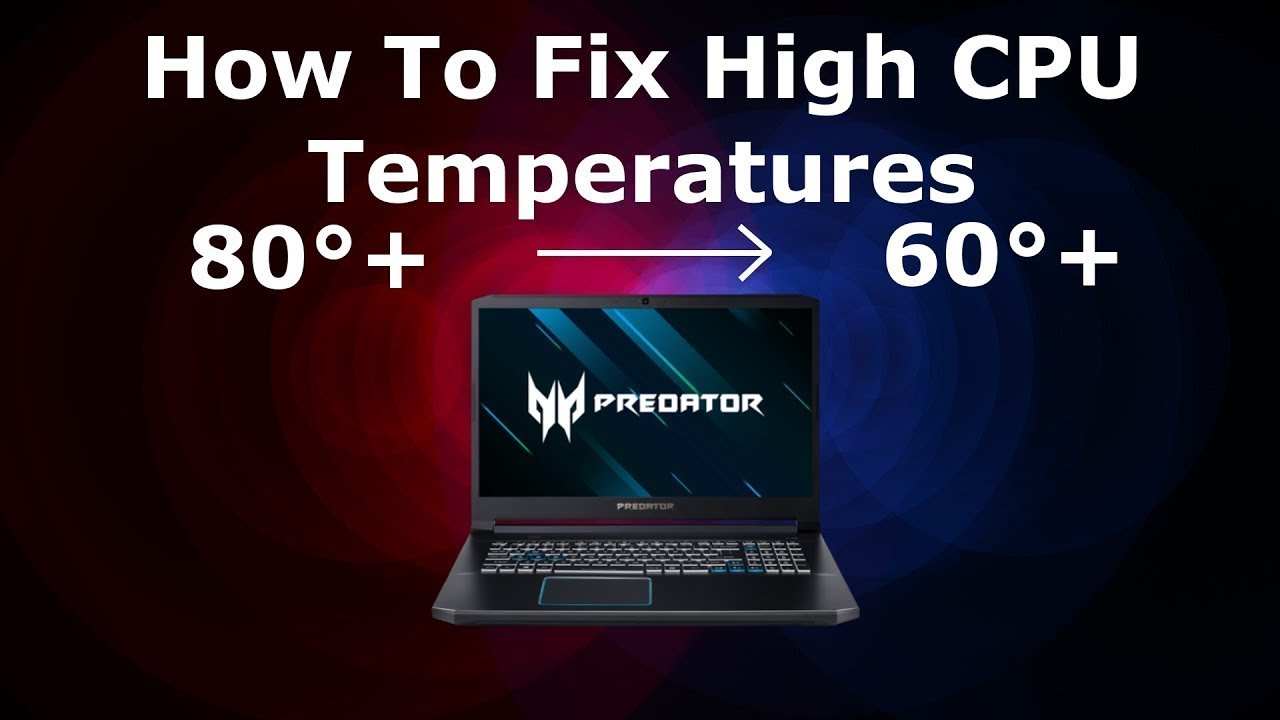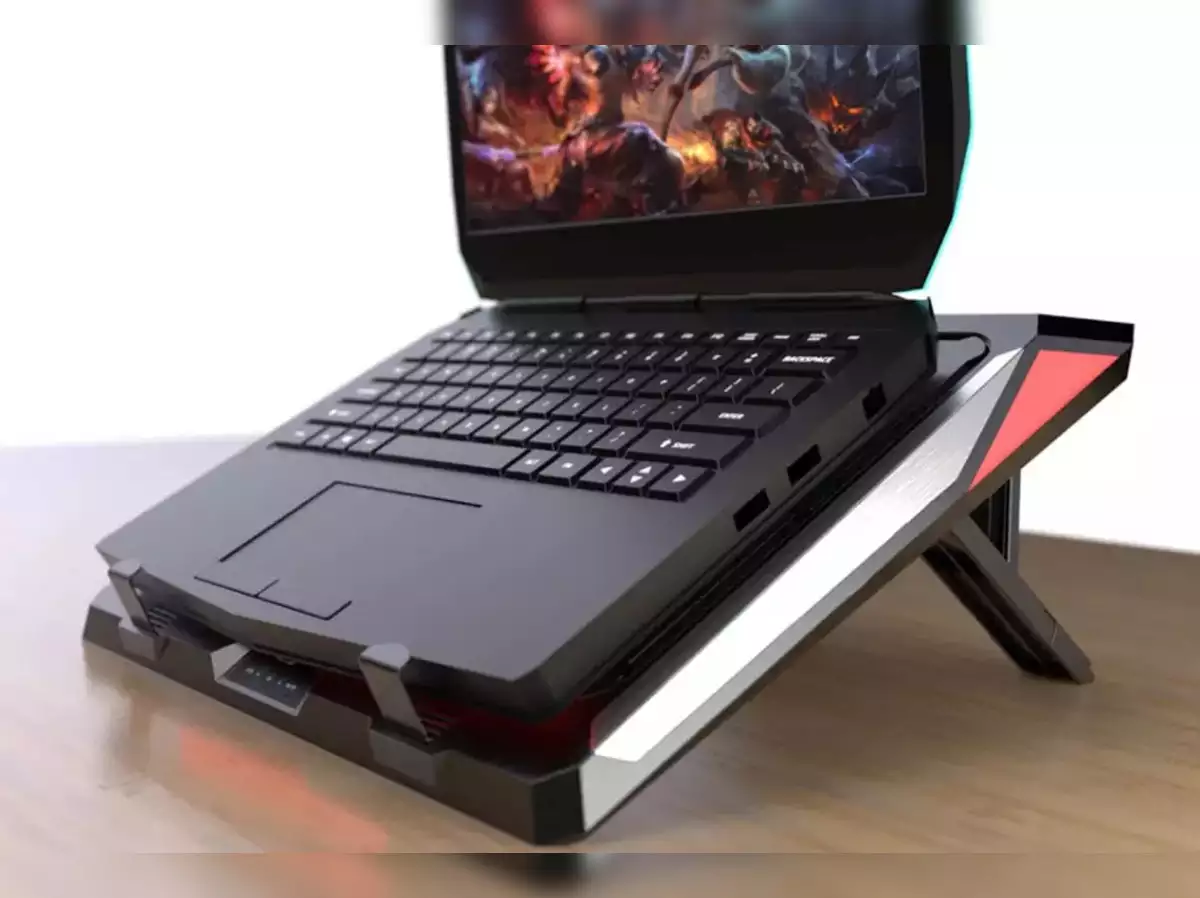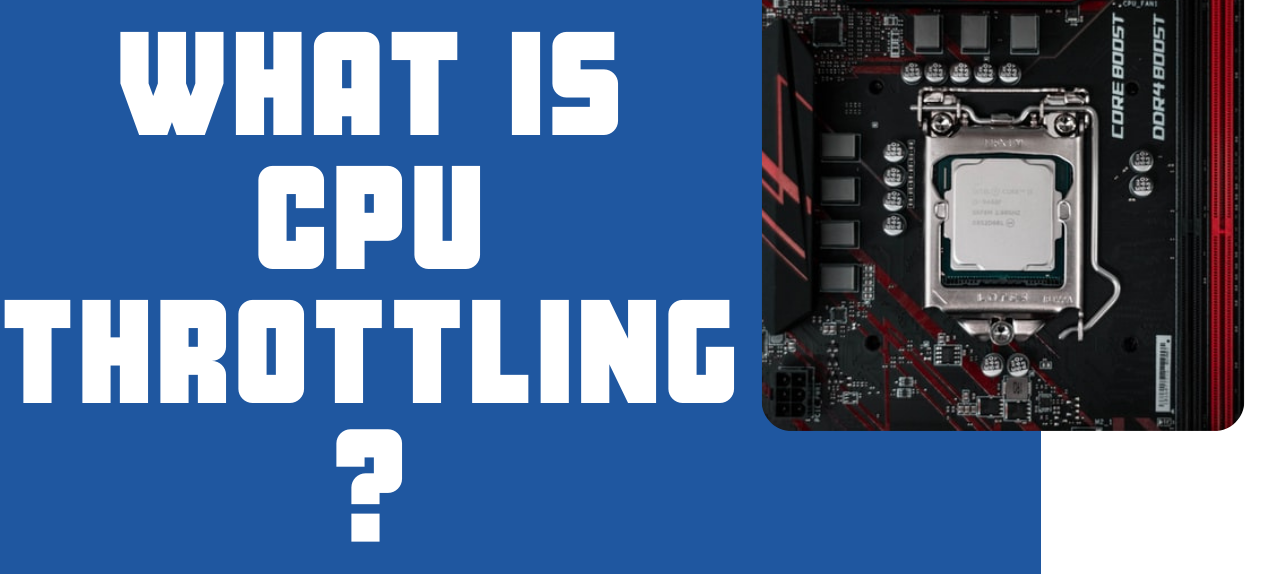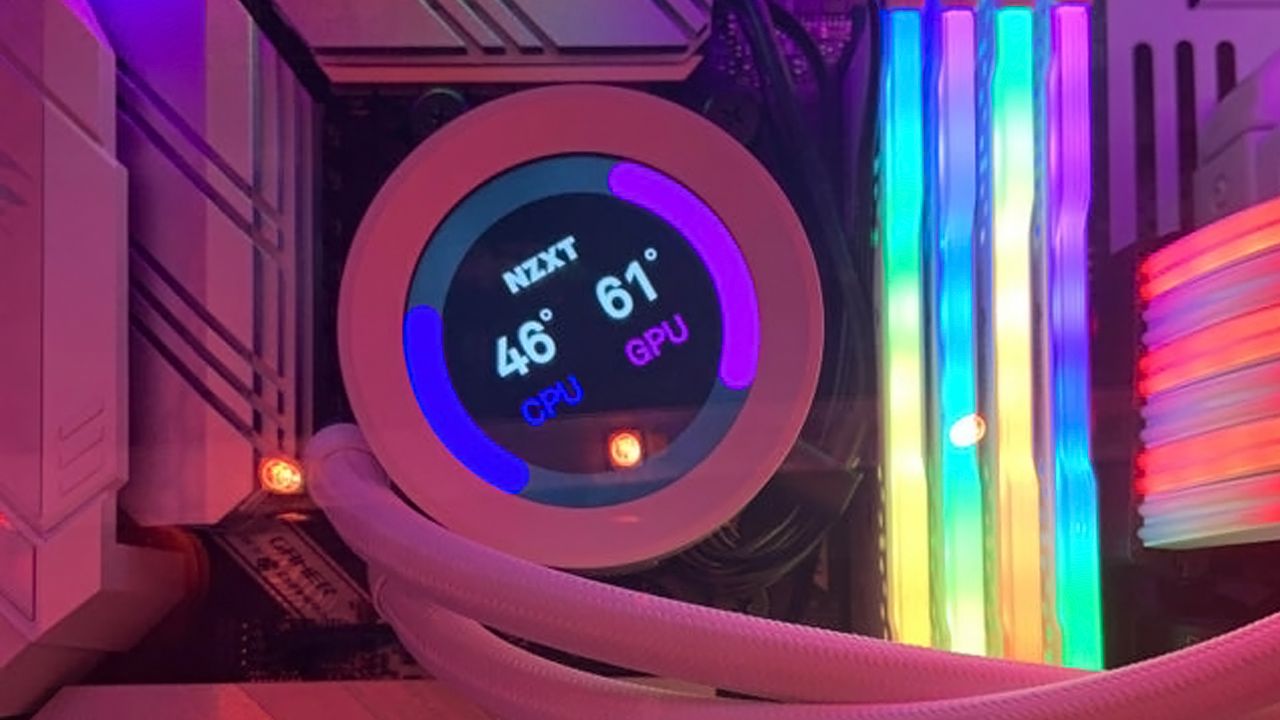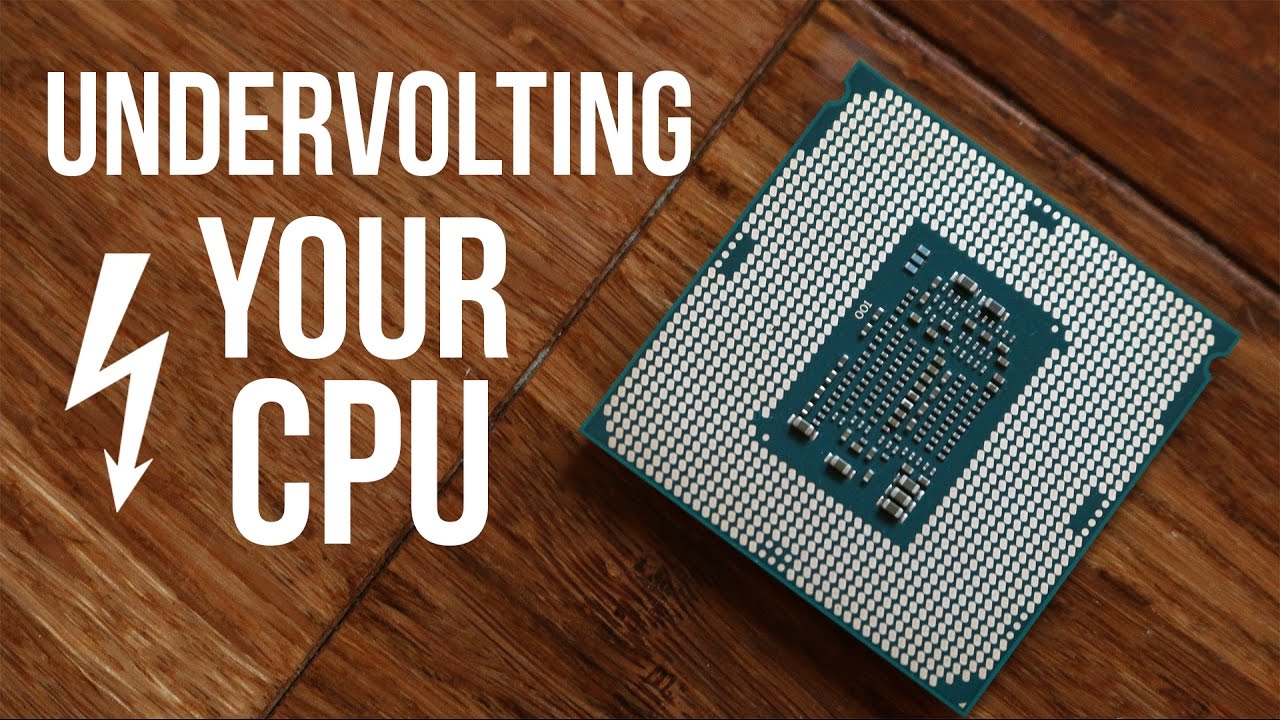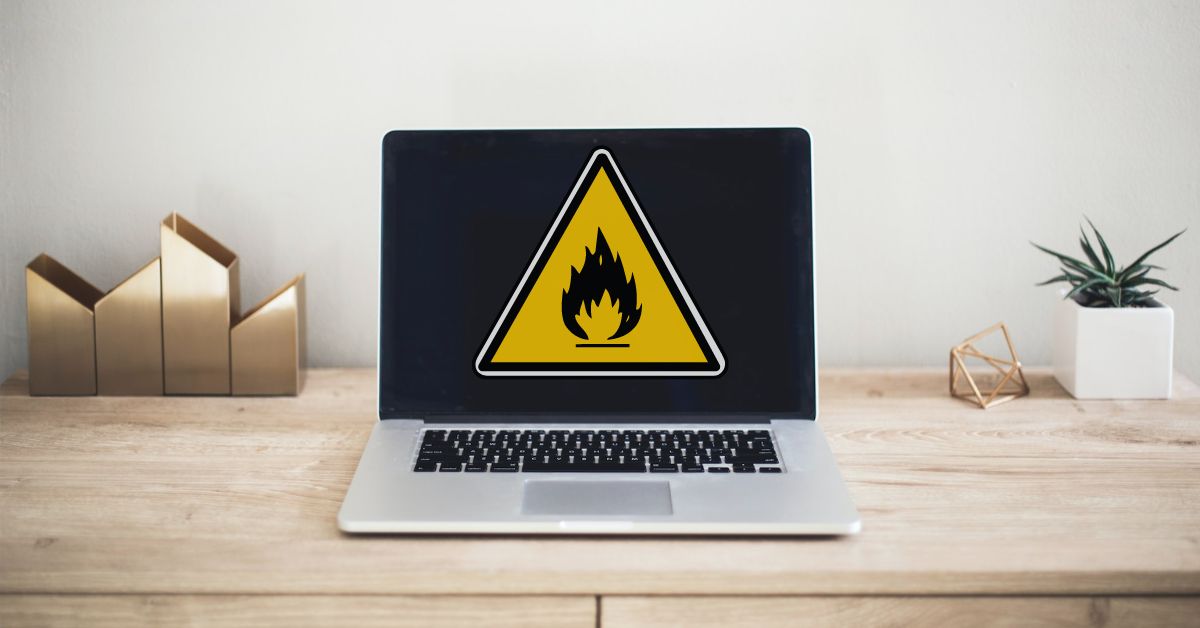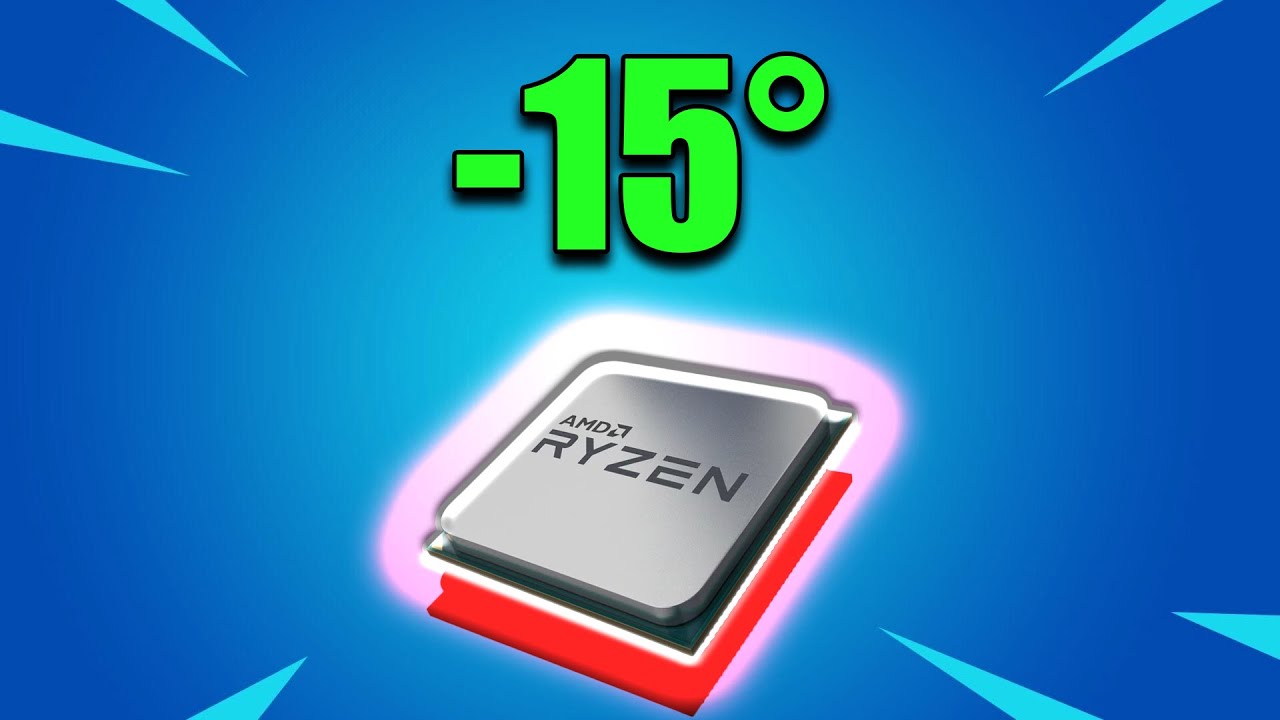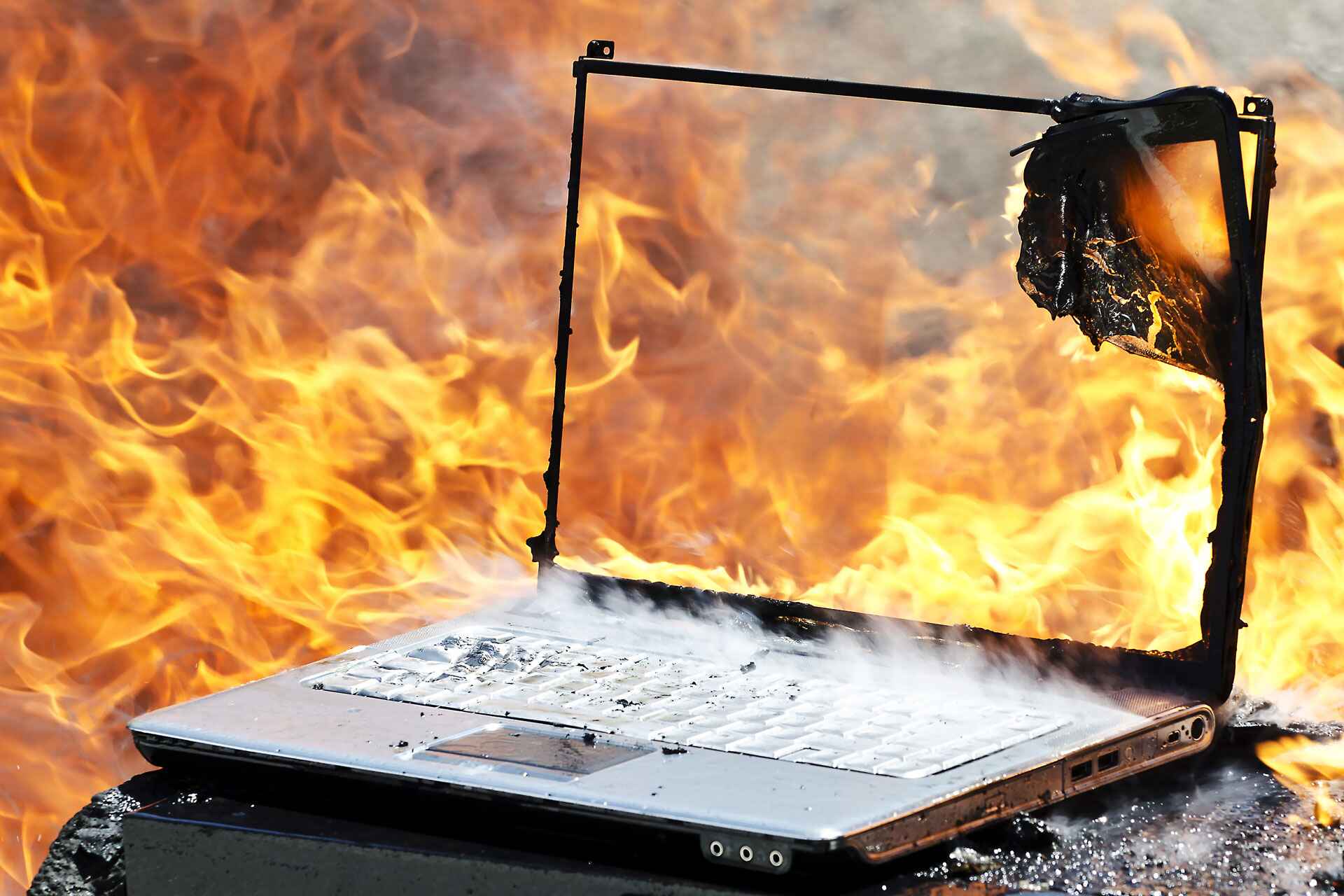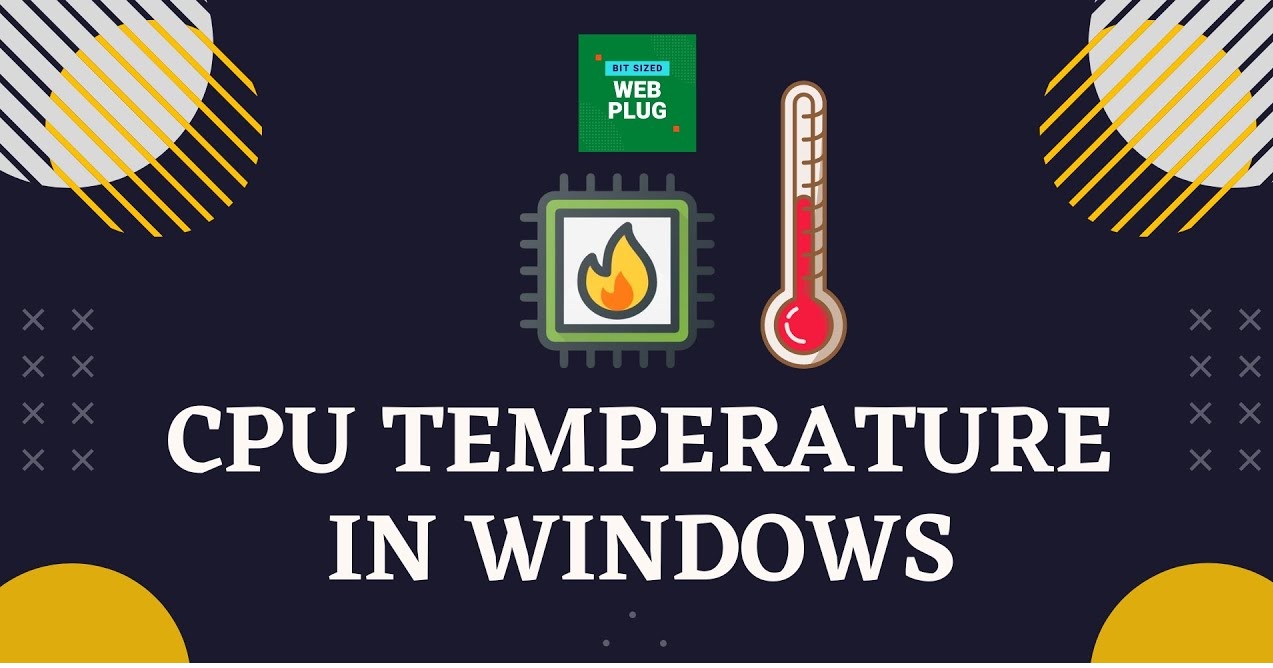Introduction
Welcome to this guide on how to lower the CPU temperature of your laptop. If you are a laptop user, you may have noticed that your device can sometimes get uncomfortably hot. This increase in temperature is primarily due to the Central Processing Unit (CPU) working at its maximum capacity, generating heat as a byproduct. While it is normal for laptops to generate heat, excessively high CPU temperatures can lead to performance issues and potential damage to your device.
Why is it important to monitor and control your laptop’s CPU temperature? Firstly, high temperatures can significantly impact the performance of your laptop. When the CPU reaches its critical temperature threshold, it may start to throttle, leading to a slower and less responsive system. Additionally, prolonged exposure to excessive heat can cause hardware components to degrade faster, reducing their lifespan. By taking proactive measures to lower your laptop’s CPU temperature, you can extend the longevity of your device and ensure optimal performance.
In this guide, we will explore several methods to help you reduce your laptop’s CPU temperature. We will start by explaining how to check your laptop’s CPU temperature, as it’s important to know how hot your device is running before applying any solutions. Next, we will discuss the common causes of high CPU temperatures, such as dust accumulation and inefficient cooling systems. Then, we will provide you with a range of practical tips and strategies to lower your laptop’s CPU temperature and keep it running cool.
It’s crucial to note that every laptop model is unique, and the effectiveness of each method may vary. Therefore, it’s recommended to try out different techniques and find the ones that work best for your specific laptop. Without further ado, let’s jump into the following sections to learn how to keep your laptop cool and improve its overall performance!
Why is your laptop CPU temperature important?
The CPU is the brain of your laptop, responsible for executing all of its tasks and processes. As the CPU carries out these operations, it generates heat. Keeping an eye on your laptop’s CPU temperature is crucial for several reasons.
Firstly, high CPU temperatures can lead to performance issues. When the CPU gets too hot, it may automatically throttle its speed to prevent damage. This can result in a noticeable slowdown in your laptop’s performance, making tasks take longer to complete and applications to become unresponsive. By optimizing your laptop’s temperature, you can ensure that the CPU operates at its full potential, delivering fast and efficient performance.
Secondly, excessive heat can potentially damage your laptop’s hardware components. Prolonged exposure to high temperatures can degrade the internal components, including the CPU itself and other vital parts such as the motherboard and graphics card. Over time, this can lead to system instability, unexpected shutdowns, and even permanent hardware failure. Monitoring and controlling your laptop’s CPU temperature can significantly extend the lifespan of your device and prevent costly repairs.
Furthermore, maintaining an ideal CPU temperature improves energy efficiency. When the CPU runs hot, it requires more power to operate effectively. This increased energy consumption not only contributes to higher electricity bills but also reduces battery life. By keeping your laptop’s CPU temperature within the recommended range, you can conserve energy and prolong battery life, making your device more environmentally friendly and cost-effective in the long run.
Lastly, excessive heat can make using your laptop uncomfortable. It can cause the laptop’s surface to become hot to the touch, making it unpleasant to use for extended periods. Additionally, overheating can lead to noisy fan operation as the cooling system works harder to regulate the temperature. By effectively managing the CPU temperature, you can ensure a more comfortable and enjoyable computing experience.
In summary, monitoring and controlling your laptop’s CPU temperature is vital for optimal performance, hardware longevity, energy efficiency, and user comfort. By keeping your CPU cool, you can enjoy faster and smoother performance, reduce the risk of hardware damage, conserve energy, and create a more pleasurable laptop experience overall.
How to check your laptop’s CPU temperature?
Before you start implementing strategies to lower your laptop’s CPU temperature, it’s important to understand how hot your device is running. Fortunately, there are several ways to check your laptop’s CPU temperature:
1. BIOS/UEFI Settings: Restart your laptop and access the BIOS/UEFI settings by pressing the designated key during startup (usually Esc, F2, or Del). Look for temperature information within the system monitoring or hardware status section. Keep in mind that accessing the BIOS/UEFI may vary depending on your laptop model.
2. Third-Party Software: Numerous third-party software options are available to monitor your CPU temperature, such as HWMonitor, Core Temp, or SpeedFan. These programs provide detailed information about your laptop’s temperature, including real-time readings and historical data. Download and install one of these tools, and open it to view your CPU temperature.
3. Task Manager: On Windows laptops, you can use the built-in Task Manager to check your CPU temperature. Right-click on the taskbar and select “Task Manager” or press Ctrl+Shift+Esc. In the Task Manager window, navigate to the “Performance” tab and click on “CPU.” Look for the temperature reading or graph provided.
4. Command Line: Tech-savvy users can utilize command-line tools to determine CPU temperature. On Windows, open the Command Prompt by pressing Win+R, typing “cmd,” and pressing Enter. Then, enter the command “WMIC /NAMESPACE:\root\wmi PATH MSAcpi_ThermalZoneTemperature” and press Enter. The temperature reading will be displayed in degrees Celsius.
5. Monitoring Software: Some laptops come with pre-installed monitoring software from the manufacturer. Check your laptop’s system utilities or driver software to see if there is any monitoring tool included. These software programs often provide detailed temperature information for various components, including the CPU.
Remember that different software or methods may provide slightly different temperature readings, so it’s essential to pay attention to the general range rather than obsessing over specific degrees. Additionally, it’s recommended to check your CPU temperature under normal usage conditions, such as when running demanding applications or performing tasks that typically cause your laptop to heat up.
By knowing your laptop’s CPU temperature, you can gauge the effectiveness of the steps you take to lower it. Regularly monitoring the temperature gives you an indication of any improvements and helps you identify if any further action is needed to keep your laptop’s CPU within a safe operating range.
Causes of high laptop CPU temperature
Several factors can contribute to high CPU temperatures in laptops. Understanding the underlying causes can help you identify and address the specific issues causing your laptop to overheat. Here are the common culprits:
1. Dust and dirt accumulation: Over time, dust and dirt can accumulate in your laptop’s cooling system, including the fan and heat sinks. This buildup restricts airflow and insulation, preventing proper heat dissipation and leading to higher CPU temperatures. Regular cleaning is essential to maintain optimal cooling performance.
2. Inadequate ventilation: Laptops with insufficient ventilation can struggle to dissipate heat properly. Blocked air vents or placing your laptop on soft surfaces like beds or couches can obstruct the intake and exhaust of cool air, resulting in higher temperatures. It is crucial to ensure that the laptop has room for proper airflow.
3. Heavy workloads: Running resource-intensive tasks such as gaming or video editing puts a significant strain on the CPU, causing it to generate more heat. In such cases, the laptop’s cooling system may struggle to keep up with the heat production, resulting in elevated CPU temperatures.
4. Outdated or malfunctioning cooling system: Over time, cooling fans can wear out or become less effective, reducing their ability to keep the CPU temperature in check. Similarly, faulty heat sinks or thermal pads can lead to poor heat transfer, contributing to higher temperatures. Regular maintenance and replacement of cooling system components can mitigate this issue.
5. Overclocking: Overclocking involves increasing the CPU’s clock speed beyond its default limits to gain extra performance. However, this also increases the power consumption and heat output of the CPU. Without adequate cooling, overclocking can push the CPU temperature to dangerous levels. It’s essential to ensure that your laptop’s cooling system can handle the increased heat generated.
6. Insufficient power settings: Laptop power settings can impact the CPU’s performance and temperature. Using high-performance power settings constantly can cause the CPU to work harder and generate more heat. Adjusting power settings to balanced or power-saving modes can help lower CPU temperatures during light usage.
7. Firmware and driver issues: Outdated or incompatible firmware and drivers can lead to inefficient operation of your laptop’s hardware components, including the cooling system. It’s vital to regularly update your laptop’s firmware (BIOS/UEFI) and drivers to ensure optimal performance and temperature management.
Identifying the specific causes of high CPU temperatures in your laptop is essential for choosing the right solutions. By addressing these underlying issues, you can effectively reduce your laptop’s CPU temperature and maintain the longevity and performance of your device.
Tips for lowering your laptop CPU temperature
Excessive heat can negatively impact your laptop’s performance and longevity. Fortunately, there are several effective strategies to help you lower the CPU temperature of your laptop. Here are some useful tips to consider:
1. Clean the cooling system: Regularly clean the cooling system, including the fan and heat sinks, to remove dust and debris. Use compressed air or a soft brush to gently dislodge and remove the buildup, improving airflow and heat dissipation.
2. Use a cooling pad or a laptop cooling fan: Invest in a cooling pad or a laptop cooling fan. These devices help boost airflow and provide additional cooling for your laptop, reducing CPU temperatures during intensive tasks.
3. Adjust your power settings: Modify your laptop’s power settings to reduce the CPU’s workload. Select a balanced or power-saving mode when performing light tasks to lower power consumption and minimize heat generation.
4. Limit background processes and tasks: Close unnecessary applications and processes running in the background. This reduces the CPU’s workload, decreasing heat production, and allowing the cooling system to operate more effectively.
5. Update your drivers and BIOS: Regularly update your laptop’s firmware (BIOS/UEFI) and drivers to ensure optimal performance and temperature management. Manufacturers often release updates that address cooling-related issues and enhance system efficiency.
6. Keep your laptop on a flat and hard surface: Place your laptop on a flat and hard surface to allow proper airflow around the device. Avoid using it on soft surfaces like beds or couches, as they can obstruct air vents and contribute to higher CPU temperatures.
7. Use a laptop stand or elevate the back: Lift the back of your laptop using a laptop stand or elevate it with a book or a wedge. This slight angle promotes better airflow and heat dissipation, helping to cool down the CPU.
8. Avoid high ambient temperatures: High ambient temperatures can further increase the heat inside your laptop. Keep your laptop in a cool and well-ventilated room, and avoid using it in direct sunlight or in hot environments to prevent additional heat buildup.
9. Monitor and control your laptop’s temperature: Continuously monitor your laptop’s CPU temperature using specialized software. This enables you to keep an eye on temperature fluctuations and take immediate action if needed to prevent overheating.
10. Consider reapplying thermal paste: If you are comfortable doing so and have experience with hardware, you can consider reapplying thermal paste to the CPU. Fresh thermal paste improves heat transfer between the CPU and the heat sink, helping to decrease CPU temperatures.
Implementing these tips can significantly lower your laptop’s CPU temperature and ensure stable and efficient performance. Experiment with different methods to find the ones that work best for your specific laptop model and usage patterns. Remember, maintaining an optimal temperature is crucial for the longevity, performance, and overall health of your laptop.
Clean the cooling system
Over time, dust and debris can accumulate in your laptop’s cooling system, hindering airflow and causing the CPU temperature to rise. Regularly cleaning the cooling system is essential to maintain optimal cooling performance and prevent overheating. Here’s how you can clean the cooling system of your laptop:
1. Gather the necessary tools: Before you begin, ensure you have the necessary tools for cleaning. You will need a can of compressed air, a soft brush or cloth, and a small screwdriver (if required to access the cooling components).
2. Shut down and disconnect: Turn off your laptop and unplug it from the power source. This step is crucial to avoid any electrical hazards while cleaning the internal components.
3. Access the cooling system: Depending on your laptop model, accessing the cooling system may require removing a panel or the keyboard. Consult your laptop’s user manual or search online for specific instructions tailored to your laptop model.
4. Clean the fan: The fan is one of the critical components that require attention. Hold the fan steady and use a can of compressed air to blow away the dust and debris. Pay particular attention to the gaps between the fan blades and the areas surrounding the fan. Use a soft brush or cloth to gently remove any remaining dirt.
5. Clean the heat sinks: The heat sinks are responsible for dissipating heat from the CPU and other components. Use the compressed air can to blow away any dust or debris accumulated on the heat sinks. Ensure that there is no obstruction blocking the fins of the heat sinks.
6. Clean other components: While you have access to the internal components, it’s beneficial to clean other areas prone to dust accumulation. Use compressed air to blow away any dirt from the motherboard, graphics card, and other nearby components. Be cautious not to touch any sensitive parts or use excessive force.
7. Reassemble and test: Once you have cleaned the cooling system and other components, carefully reassemble the laptop. Ensure all screws are tightened securely. Then, power on your laptop and observe the impact of the cleaning on the CPU temperature. You should notice a reduction in temperature and improved cooling performance.
8. Regular maintenance: Cleaning the cooling system is not a one-time task. It’s recommended to perform this maintenance every few months, depending on your usage and the environment you use your laptop in. Regular cleaning prevents excessive dust buildup and ensures optimal cooling efficiency.
By regularly cleaning your laptop’s cooling system, you remove the accumulated dust and debris that hinder airflow and contribute to high CPU temperatures. This simple yet effective maintenance task can significantly improve your laptop’s cooling performance, preventing overheating and prolonging the lifespan of your device.
Use a cooling pad or a laptop cooling fan
If you frequently use your laptop for resource-intensive tasks or notice that it runs hot during extended periods of use, using a cooling pad or a laptop cooling fan can help lower the CPU temperature. These devices are specifically designed to enhance the cooling performance of your laptop by improving airflow and dissipating heat more effectively. Here’s how they can help:
1. Cooling pads: Cooling pads are flat platforms with built-in fans that sit underneath your laptop. These fans draw cool air from the surroundings and direct it towards the laptop’s underside, helping to dissipate heat. Cooling pads often have adjustable fan speeds and ergonomic designs that offer comfortable typing angles. They not only lower the CPU temperature but also provide a more comfortable user experience.
2. Laptop cooling fans: Laptop cooling fans are portable devices that you can place on or around your laptop to provide additional airflow and cooling. These fans are compact and lightweight, making them easy to carry along with your laptop. They typically connect to a USB port on your laptop for power supply and offer adjustable fan speeds to meet your cooling needs. Some laptop cooling fans also come with adjustable stands or brackets to elevate the laptop for better airflow.
3. Benefits of using cooling pads or laptop cooling fans: Using a cooling pad or cooling fan can have several benefits in lowering your laptop’s CPU temperature:
– Improved airflow: These devices help increase airflow around the laptop, preventing heat from getting trapped and allowing cool air to reach the crucial components of your laptop, including the CPU.
– Heat dissipation: Cooling pads and laptop cooling fans enhance the heat dissipation process, facilitating the transfer of heat away from the laptop. This lowers the overall temperature of the CPU and other internal components.
– Reduced thermal throttling: Adequate cooling helps minimize thermal throttling, which occurs when the CPU temperature reaches its maximum threshold, leading to decreased performance. By lowering the CPU temperature, cooling pads and fans can prevent or mitigate thermal throttling, resulting in smoother and more consistent performance.
– Extended laptop lifespan: By keeping the CPU temperature within optimal limits, cooling pads and fans can help extend the lifespan of your laptop. Excessive heat can cause components to deteriorate faster, potentially leading to permanent damage. By providing effective cooling, these accessories help preserve the longevity of your laptop.
4. Choosing the right cooling pad or fan: When selecting a cooling pad or laptop cooling fan, consider factors such as fan speed, noise level, portability, and compatibility with your laptop model. Look for well-reviewed products from reliable brands that meet your specific cooling needs and preferences.
By using a cooling pad or a laptop cooling fan, you can significantly lower your laptop’s CPU temperature, ensuring better performance and longer lifespan for your device. These accessories are simple yet effective solutions for combating heat buildup and maintaining optimal temperatures during demanding tasks or extended usage periods.
Adjust your power settings
Adjusting your laptop’s power settings can have a significant impact on the CPU temperature. By selecting the appropriate power mode, you can effectively manage power consumption and reduce the workload on the CPU, resulting in lower temperatures. Here’s how you can optimize your power settings:
1. Power plans: Most laptops come with predefined power plans, such as “Power Saver,” “Balanced,” and “High Performance.” These plans control the CPU’s performance and power usage. To adjust your power plan, go to the Control Panel or the Settings app on your laptop and navigate to the “Power Options” section.
2. Balanced mode: The balanced power mode is a good choice for everyday use. It provides a balance between power savings and performance. In this mode, the CPU’s performance is optimized to meet your needs while conserving power and generating less heat. Select the balanced power plan to reduce the CPU workload and lower temperatures, especially during light usage.
3. Power-saving mode: If you primarily perform simple tasks like web browsing, word processing, or watching videos, consider using the power-saving mode. This mode prioritizes power savings over performance, significantly reducing the CPU’s clock speed and power consumption. It helps keep the CPU temperature in check and extends battery life, making it ideal for prolonged usage on battery power.
4. Customize power settings: If the predefined power plans do not suit your requirements, you can customize your power settings to achieve the desired balance between performance and temperature control. Within the power options, you can modify settings such as CPU performance, maximum processor state, and cooling policy.
5. Processor power management: Access the advanced power settings to adjust the processor power management options. Here, you can control the minimum and maximum processor states, specifying the lowest and highest CPU clock speeds that the system can utilize. Lowering the maximum processor state can effectively reduce the power consumption and heat generation of the CPU.
6. Cooling policy: Another setting to consider is the cooling policy. By default, laptops are configured to balance power savings and cooling performance. However, you can change the cooling policy to prioritize active cooling over power savings. This ensures that the cooling system remains active even during periods of lower CPU utilization, helping to maintain lower temperatures.
7. Power settings for gaming: If you are running graphic-intensive games or resource-demanding applications, it’s recommended to switch to the high-performance power plan temporarily. This mode allows the CPU to operate at its maximum clock speed, providing the necessary performance for a smooth gaming experience. However, be mindful of the increased power consumption and heat generation during this mode.
By adjusting your laptop’s power settings, you can significantly influence the workload and power consumption of your CPU, resulting in lower temperatures. Balancing power savings and performance ensures efficient operation while keeping the CPU cool and promoting longevity. Experiment with different power modes and settings to find the optimal configuration for your specific usage patterns and needs.
Limit background processes and tasks
Having multiple background processes and tasks running simultaneously can put a significant strain on your laptop’s CPU, leading to increased heat generation and higher temperatures. By limiting these unnecessary processes and tasks, you can reduce the workload on the CPU and effectively lower its temperature. Here are some effective ways to achieve this:
1. Task Manager: Open the Task Manager by right-clicking on the taskbar and selecting “Task Manager” or by using the Ctrl+Shift+Esc shortcut. In the Task Manager window, switch to the “Processes” or “Details” tab, and sort the processes by CPU usage. Identify processes that consume a considerable amount of CPU resources and are not essential for your current tasks. Right-click on these processes and select “End Task” to terminate them.
2. Startup programs: Many programs automatically start when you boot up your laptop, running in the background and utilizing CPU resources. Review the list of startup programs and disable the ones that you don’t need to run in the background continuously. To manage startup programs, open the Task Manager, switch to the “Startup” tab, and disable the programs that you want to prevent from starting automatically.
3. Background apps: Windows 10 and other modern operating systems allow certain apps to run in the background by default. These apps can consume CPU resources even when you are not actively using them. To manage background apps in Windows 10, go to “Settings” > “Privacy” > “Background apps” and disable apps that you don’t require to run in the background.
4. Browser extensions: Browser extensions and add-ons can also contribute to increased CPU usage, especially those that constantly run in the background or perform resource-intensive tasks. Review your installed browser extensions and disable or remove the ones that you don’t regularly use or that have a significant impact on CPU usage.
5. Scheduled tasks: Some applications and system processes may set up scheduled tasks that run in the background at specified intervals. Analyze your scheduled tasks and disable or adjust the ones that are unnecessary or consume excessive CPU resources. Use the Task Scheduler tool in Windows to manage and modify scheduled tasks.
6. Software updates and scans: Software updates and antivirus scans can significantly impact CPU performance and temperature. Schedule software updates to occur during periods of low usage or when your laptop is connected to a power source. Similarly, set antivirus scans to run at a convenient time when they will have minimal impact on your CPU performance.
7. Streamline running applications: Limit the number of applications you have running simultaneously, especially resource-demanding ones such as video editing software or games. Close any unused applications or background processes that are not necessary for your current work or browsing session.
By limiting background processes and tasks, you can lighten the CPU workload and reduce the heat generated by your laptop. This helps maintain lower CPU temperatures, improving overall performance and reducing the risk of overheating. Regularly review and manage these processes to ensure your laptop operates more efficiently and remains cool during extended usage sessions.
Update your drivers and BIOS
Keeping your laptop’s drivers and BIOS (Basic Input/Output System) up to date is crucial for maintaining optimal performance and managing CPU temperature effectively. Outdated or incompatible drivers and BIOS versions can lead to inefficient operation, including inadequate cooling system performance. Here’s why and how you should update them regularly:
1. Updated drivers: Drivers are software programs that facilitate communication between your laptop’s hardware components and the operating system. Manufacturers frequently release driver updates that address performance issues, enhance compatibility, and improve efficiency. Outdated drivers can result in suboptimal performance and inadequate heat management. Visit your laptop manufacturer’s website or the component manufacturer’s website to regularly check for driver updates specific to your laptop model.
2. BIOS updates: The BIOS is firmware embedded in your laptop’s motherboard that initializes hardware components during the boot process. BIOS updates often include improvements related to power management, temperature control, and overall system stability. It’s important to visit your laptop manufacturer’s website and check for BIOS updates specifically designed for your laptop model. Follow the manufacturer’s instructions carefully to ensure a successful update without any risk of damaging your laptop.
3. Check for automatic update options: Some laptop manufacturers provide dedicated software utilities that allow you to automatically check for and install driver and BIOS updates. These utilities simplify the update process and ensure that you have the latest stable versions for your laptop. Look for such utilities on your laptop manufacturer’s website or within the support section of their software offerings.
4. Benefits of updating: Updating your drivers and BIOS can provide several benefits in terms of CPU temperature management:
– Improved efficiency: Updated drivers and BIOS versions often include performance optimizations and enhancements, leading to more efficient operation. This can result in better heat management, leading to lower CPU temperatures.
– Enhanced compatibility: Driver and BIOS updates can address compatibility issues with new software or hardware, ensuring that all components work together smoothly. Improved compatibility can help optimize your laptop’s cooling system performance and maintain lower temperatures.
– Bug fixes: Driver and BIOS updates frequently fix stability issues, including those related to thermal management. These fixes can result in better overall temperature control and prevent temperature-related performance degradation.
5. Caution while updating: While updating drivers and BIOS is important, it’s essential to exercise caution during the update process. Follow the manufacturer’s instructions carefully and make sure you have a stable power source to prevent any interruptions that could lead to system malfunctions. If you are unsure about the update process or concerned about potential risks, consult with technical support or a professional for assistance.
By regularly updating your drivers and BIOS, you ensure optimal performance and temperature management for your laptop. Updated drivers and BIOS versions often include essential improvements that enhance heat management, improve efficiency, and ensure compatibility. Make it a habit to check for updates from your laptop manufacturer and install them regularly to effectively manage your laptop’s CPU temperature.
Keep your laptop on a flat and hard surface
The surface on which you place your laptop can have a significant impact on its temperature. Keeping your laptop on a flat and hard surface is essential for promoting proper airflow, facilitating effective heat dissipation, and lowering the CPU temperature. Here’s why this practice is important and how you can achieve it:
1. Airflow and heat dissipation: Placing your laptop on a flat and hard surface ensures that there is adequate space for air to flow around the device. This allows the cooling system to function optimally by drawing in cool air and expelling hot air. When the laptop is on a soft or uneven surface, such as a bed or a cushion, it can obstruct the air vents, impeding airflow and hindering heat dissipation. This can result in higher CPU temperatures.
2. Laptop cooling system efficiency: Laptops are designed with internal fans and heat sinks to cool down the CPU and other components. These cooling systems work most effectively when the laptop is placed on a flat and hard surface. The solid surface allows the laptop’s cooling pads and heat sinks to make direct contact, enhancing heat transfer and improving the overall cooling performance.
3. Elevate the laptop if necessary: If your laptop has bottom air vents, consider using a laptop stand, book, or any other suitable object to elevate the back of the laptop slightly. This creates a slight tilt, which promotes better airflow underneath the device. The raised angle allows cool air to enter more easily and hot air to escape, assisting in maintaining lower temperatures.
4. Use a hard-surfaced desk or table: Whenever possible, place your laptop on a hard-surfaced desk or table. Wooden or metal surfaces tend to be better choices compared to soft surfaces like carpets or clothing. These hard surfaces provide a stable and level platform for your laptop, ensuring proper heat dissipation and preventing any restriction of airflow.
5. Lap desks or laptop trays: If you prefer working with your laptop on your lap, consider using a lap desk or an ergonomic laptop tray. These accessories provide a solid and flat surface that helps maintain airflow around your laptop. They often include built-in cooling fans or ventilation channels, further aiding in heat dissipation.
6. Avoid covering the air vents: When placing your laptop on any surface, ensure that the air vents, usually located on the sides or bottom of the device, remain uncovered and unobstructed. Covering these vents can restrict the inflow and outflow of air, leading to higher CPU temperatures.
By keeping your laptop on a flat and hard surface, you enable the cooling system to perform optimally, ensuring efficient heat dissipation and lower CPU temperatures. Consistently following this practice can help prevent your laptop from overheating and potentially improve its overall performance and longevity.
Use a laptop stand or elevate the back
Using a laptop stand or elevating the back of your laptop can significantly contribute to reducing CPU temperatures and improving overall heat dissipation. These methods help optimize airflow around your laptop, allowing it to stay cool even during demanding tasks. Let’s explore why using a laptop stand or elevating the back of your laptop is beneficial and how you can implement them:
1. Improved airflow: Placing your laptop on a stand or elevating the back allows for better airflow underneath the device. This setup enables cool air to enter more easily through the bottom vents while aiding in the expulsion of hot air from the top vents or side grilles. Improved airflow prevents heat buildup around the CPU and other internal components, resulting in lower temperatures.
2. Heat dissipation: When the back of your laptop is elevated or resting on a stand, it increases the distance between the laptop body and the surface it sits on. This additional space allows for improved heat dissipation. The increased air gap facilitates better convection, allowing the laptop’s cooling system to efficiently transfer heat away from the CPU and other heat-generating components.
3. Ergonomic benefits: Using a laptop stand or elevating the back of your laptop also provides ergonomic advantages. It helps maintain a more comfortable typing and viewing angle, reducing strain on your wrists, neck, and back. This ergonomic setup allows you to work or browse on your laptop for extended periods without discomfort. Many laptop stands also come with adjustable angles, allowing you to customize the height and tilt to your preference.
4. Laptop stand options: There are various laptop stands available to suit different preferences and needs. Some stands are designed specifically for laptops and come in different sizes to accommodate various laptop sizes. Others are multi-purpose and can be used with both laptops and tablets. They can be made of materials such as metal, plastic, or wood. Choose a laptop stand that is stable, sturdy, and portable so that you can easily carry it with your laptop.
5. Alternative elevation methods: If you don’t have access to a laptop stand, you can achieve a similar effect by elevating the back of your laptop using different objects. Place objects like books, shoeboxes, or sturdy blocks underneath the back edges of your laptop. This makeshift elevation increases the angle of the keyboard and allows for better airflow.
6. Cooling pad combination: To maximize cooling, you can combine the use of a laptop stand with a cooling pad. Place the cooling pad on the stand or elevate the back of the laptop using the stand, ensuring that the cooling pad’s fans align with the laptop’s intake vents. This setup enhances both airflow and active cooling, resulting in even lower CPU temperatures.
By using a laptop stand or elevating the back of your laptop, you promote better airflow, improve heat dissipation, and enhance your overall laptop experience. Whether you choose a dedicated laptop stand or employ alternative elevation methods, these practices help keep your laptop cool during extended usage and contribute to a more comfortable and efficient computing environment.
Avoid high ambient temperatures
The surrounding environment’s temperature can have a direct impact on your laptop’s CPU temperature. High ambient temperatures can make it more challenging for your laptop’s cooling system to regulate heat and maintain lower CPU temperatures. By avoiding high ambient temperatures, you can help keep your laptop running cool and prevent overheating. Here are some tips to consider:
1. Keep your laptop in a cool location: Choose a cool and well-ventilated room or area to use your laptop. Avoid placing it in areas that receive direct sunlight or are exposed to heat sources like radiators or space heaters. Direct exposure to sunlight or sources of heat can significantly raise the ambient temperature, potentially leading to increased CPU temperatures.
2. Use air conditioning or fans: If possible, use air conditioning or fans to keep the room temperature cool. Lower ambient temperatures provide a conducive environment for your laptop’s cooling system to operate efficiently. The cool air from air conditioning or fans can help in dissipating heat from the laptop and prevent excessive heat buildup.
3. Avoid using your laptop on soft surfaces: Soft surfaces like beds, couches, or blankets can trap heat underneath your laptop. These surfaces restrict airflow, leading to higher CPU temperatures. Instead, opt for using your laptop on hard and flat surfaces like desks or tables that allow for better air circulation and heat dissipation.
4. Use a laptop cooling pad or external fan: Consider using a laptop cooling pad or an external fan to supplement your laptop’s built-in cooling system. These accessories provide additional air circulation around your laptop, helping to counteract higher ambient temperatures. The extra airflow assists in cooling down the CPU and maintaining optimal operating temperatures.
5. Avoid high-temperature environments: Be mindful of your laptop’s exposure to high-temperature environments, such as leaving it in a car on a hot day. High temperatures, such as those found in a closed car, can cause rapid heat buildup and potentially damage your laptop’s internal components. Whenever possible, keep your laptop in temperature-controlled environments to avoid excessive heat stress.
6. Consider laptop cooling solutions: In extreme or consistently high-temperature environments, you may want to explore more advanced laptop cooling solutions. These include laptop cooling pads with built-in fans, laptop stands with active cooling, or even liquid cooling systems designed specifically for laptops. These solutions are more effective at dissipating heat and maintaining lower CPU temperatures in demanding and high-temperature conditions.
By avoiding high ambient temperatures, you create a cooler environment for your laptop to operate in. Creating a conducive environment for heat dissipation allows your laptop’s cooling system to function optimally, resulting in lower CPU temperatures and reduced risk of overheating. Implementing these measures is particularly important during hot weather or if you often use your laptop in warm environments.
Monitor and control your laptop’s temperature
Monitoring and controlling your laptop’s temperature is essential for maintaining optimal performance and preventing overheating. By regularly checking the CPU temperature, you can identify potential issues and take proactive measures to ensure that your laptop runs within safe temperature limits. Here’s how to monitor and control your laptop’s temperature effectively:
1. Use temperature monitoring software: Install temperature monitoring software on your laptop to keep track of the CPU temperature. There are several free and paid options available, such as Core Temp or HWMonitor. These programs provide real-time temperature readings and often include additional features like temperature logging and alarms when the temperature exceeds a certain threshold.
2. Know the safe temperature range: Familiarize yourself with the safe temperature range for your specific laptop model. Consult the manufacturer’s documentation or visit their website for specifications regarding the acceptable operating temperature limits. This knowledge allows you to assess whether your laptop’s temperature is within a safe range or if it requires further attention.
3. Monitor during demanding tasks: Pay particular attention to the CPU temperature when performing resource-intensive tasks like gaming, video editing, or running heavy software applications. These activities put additional strain on your laptop and can result in higher temperatures. Monitoring the temperature during these tasks ensures that you are aware of any potential overheating issues and can take appropriate action if needed.
4. Take breaks and allow for cooling: If you notice that your laptop’s temperature is approaching the upper limits during intensive usage, take breaks to allow your laptop to cool down. Shut it down or put it in sleep mode for a while, allowing the temperature to drop. During these breaks, make sure your laptop has adequate airflow to dissipate heat effectively.
5. Adjust cooling settings: Some laptops have built-in cooling profiles or software utilities that allow you to adjust cooling settings. Experiment with these settings to optimize your laptop’s cooling performance. You may have options to increase fan speed or enable more aggressive cooling. However, be mindful of the noise generated by increased fan speeds.
6. Clean and maintain your laptop: Regularly clean the cooling system and ensure proper maintenance of your laptop. Dust and debris accumulation can hinder heat dissipation, leading to higher CPU temperatures. Additionally, check for any physical obstructions that may block the air vents or hinder the cooling system’s efficiency.
7. Seek professional help if needed: If you notice consistently high CPU temperatures or your laptop experiences frequent overheating, it may indicate an underlying hardware issue. In such cases, it’s advisable to seek professional assistance. Contact the laptop manufacturer’s support team or consult a qualified technician to diagnose and resolve any hardware-related problems.
By monitoring and controlling your laptop’s temperature, you can identify potential issues early on and take appropriate steps to prevent overheating. Regular temperature monitoring allows you to maintain your laptop’s performance, prolong its lifespan, and ensure a stable and efficient computing experience.
Consider reapplying thermal paste
Thermal paste, also known as thermal compound or thermal grease, plays a critical role in facilitating heat transfer between the CPU and the heatsink. Over time, the thermal paste can dry out, become less effective, and hinder heat dissipation, leading to higher CPU temperatures. Reapplying thermal paste can help restore optimal heat transfer and lower the CPU temperature. Here’s how to consider and undertake this task:
1. Assess the need for reapplication: If you observe consistently high CPU temperatures, even after cleaning the cooling system and optimizing other factors, it may be time to consider reapplying thermal paste. This is particularly relevant if you have been using your laptop for several years or notice degraded cooling performance.
2. Gather the necessary tools: To reapply thermal paste, you will need a few tools, including high-quality thermal paste, isopropyl alcohol, lint-free cloth or cotton swabs, and a screwdriver (if required to access the CPU heatsink).
3. Safety precautions: Before proceeding, ensure that your laptop is completely turned off, disconnected from the power source, and cooled down. Precautions must be taken to prevent accidental damage to the laptop or any internal components during the reapplication process. Consult your laptop’s user manual or search for specific instructions tailored to your laptop model.
4. Disassemble the cooling system: Depending on your laptop model, you may need to disassemble the cooling system to access the CPU and heatsink. Follow the manufacturer’s instructions or consult guides specific to your laptop model. Take caution not to damage any components during this process.
5. Clean the CPU and heatsink: Use isopropyl alcohol and a lint-free cloth or cotton swabs to carefully clean the old thermal paste from the CPU and the heatsink. Eliminate any residue, making sure both surfaces are clean and free from any contaminants that could hinder heat transfer.
6. Apply new thermal paste: Apply a small, pea-sized amount of fresh thermal paste to the center of the CPU. Use a credit card or a plastic spatula to spread the paste evenly across the CPU surface. Avoid using excessive amounts of thermal paste, as this can create a mess and potentially cause performance issues.
7. Reassemble and test: Once you have applied the thermal paste, reassemble the cooling system carefully. Ensure all screws are tightly secured but not overly tightened. Power on your laptop and monitor the CPU temperature to evaluate the impact of the thermal paste reapplication. You should notice improved heat transfer and lower CPU temperatures, contributing to better cooling performance.
8. Repeat as necessary: Thermal paste can deteriorate over time, so you may need to periodically reapply it to maintain optimal heat transfer. Monitor your CPU temperatures regularly and consider reapplying thermal paste if you notice a significant increase in temperatures over an extended period.
Reapplying thermal paste is a more advanced task that requires caution and technical knowledge. If you feel uncomfortable or unsure, it is recommended to seek assistance from a professional technician who can perform the task correctly and safely.
By reapplying thermal paste, you can improve the thermal conductivity between the CPU and heatsink, resulting in better heat dissipation and lower CPU temperatures. This simple maintenance task can help prolong your laptop’s lifespan, enhance cooling performance, and ensure efficient operation under demanding workloads.
Conclusion
Managing and lowering your laptop’s CPU temperature is crucial for maintaining optimal performance and prolonging its lifespan. Excessive heat can lead to performance issues, hardware damage, and an uncomfortable user experience. By implementing the tips and strategies mentioned in this guide, you can effectively reduce your laptop’s CPU temperature and improve its overall cooling performance.
Throughout this guide, we discussed various methods to help you lower your laptop’s CPU temperature. From cleaning the cooling system and using cooling pads or laptop cooling fans to adjusting power settings and monitoring temperature, each strategy contributes to creating a cooler and more efficient laptop environment.
Understanding the importance of monitoring and controlling your laptop’s temperature allows you to identify potential issues and take proactive measures before they escalate. Regularly monitoring your CPU temperature and staying within safe operating limits ensures that your laptop runs smoothly and prevents any long-term damage caused by excessive heat.
Remember that every laptop model is unique, and the effectiveness of each strategy may vary. It’s recommended to experiment and find the combination of methods that work best for your specific laptop and usage patterns.
By following the guidelines in this guide, you can enjoy a cooler and more efficient laptop experience. Lower CPU temperatures not only enhance performance and longevity but also contribute to a comfortable working environment, allowing you to work or play without worries of overheating.
Take the necessary steps to keep your laptop running cool, and regularly maintain its cooling system to prevent any potential issues. With proper care and attention, you can ensure your laptop stays within safe temperature ranges and delivers optimal performance for years to come.







